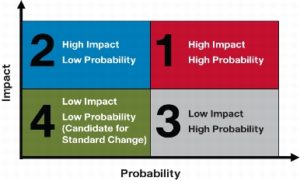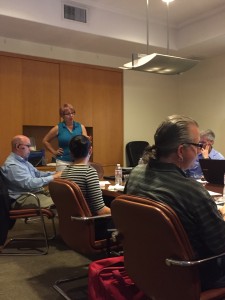Medical Devices should have Zero Recalls & Practically Painless FDA Audits
Do you want to be the Product Reliability Hero? Here’s the secret: “Impact vs Probability”
Those companies who build Safe & Reliable Medical Devices – use this formula.
I was a Quality Assurance Consultant on a project for a Fortune 100 company in LA – where I witnessed the power of this tool, first hand.
An Analyst was brought in from one of the Top 5 Product Advisory Agencies in the country, and the entire cross-functional team came together for this amazing session, which was designed to determine exactly where everyone would focus all their time & energy.
We needed to deliver a mission critical project on time, with maximum reliability and with minimal risk to our Fortune 500 clients.
This entailed replacing outdated, backend credit card transaction technology with a newer system that provided faster processing; because it impacted all aspects of the core technology the risk was huge … especially since there was a tight delivery schedule.
The Analyst was introduced by the CEO and he made it crystal clear – the Analyst was in charge today and would get whatever she wanted from everyone in the room. He set the tone.
It was breathtaking to see every executive, director and manager – along with everyone who reported to them – riveted by this introduction.
Then the Analyst started.
She began by explaining what we were going to do, and she started by drawing this diagram on the whiteboard, labeled Impact Vs Probability

She walked everyone through the 4 Quadrants and explained what each one represented – and it soon became apparent where we needed to focus our time & energy; on activities in Quadrant 1.
Therefore – we needed to determine what those activities were.
This is where it got fun.
She went around the room and asked for every single person to provide at least 5 suggestions, or scenarios, about which existing feature, function or technology would be impacted by the new changes to the system.
Once we got started, everyone began shouting out their ideas and she wrote them on the whiteboard.
Within a few hours, that wall sized whiteboard was completely covered with every “what if” scenario imaginable. If we make this change, what else could be affected? Which systems would be impacted – that we weren’t making changes to – simply because they integrated with the affected technology?
After a while it was pretty clear how great the overall risks were and what the potential impact could be.
Then she walked through every item on the whiteboard – and with everyone’s agreement – labeled them with the number pertaining to the Quadrant it belonged to.
For example – if the font color in the help section was wrong – and a customer found it…the would be a low probability/low impact item.
However – if a key feature was broken, it was highly likely the customer would find it and would be negatively impacted. High probability/High Impact.

As she explained – it all comes down to Risk.
After we finished the session – everyone felt a greater degree of confidence that we could deliver this project successfully, because we knew we’d determined every High Risk area, and therefore what our responsibilities were. Everyone was on the same page.
That project succeeded and we released on time, on budget – with no surprises – and with maximum reliability – because we narrowed our focus early on and we stayed on target until we finished.
For me, the lesson is clear.
Realize that, it’s not what we spend our time on that matters – it’s what we don’t waste valuable time on, that provides the greatest potential for success.
Identify and Focus ONLY on the High Risk Areas, set aside the rest – measure and adjust to ensure we’re staying on track – and we will deliver extremely reliable products on a consistent and predictable basis.
The bottom line:
If we use this Valuable Tool to identify the target & keep our focus on the critical path – we will increase corporate profitability by orders of magnitude faster than otherwise possible and it will be our Product Development Formula for success.



